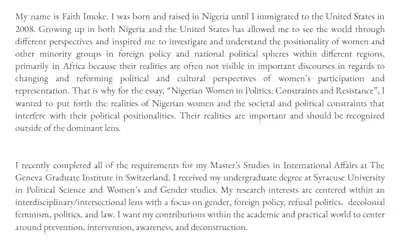Wake Work in Black Markets
3.1 Introduction
It’s not possible to constantly hold onto crisis. You have to have the magic. That’s also life.
-Toni Morrison
In the previous chapters, I have elaborated on the conditions that place Black entrepreneurs “in the wake” but it would be a mistake to think that’s all there is. There is also so much light. News articles have described Black Market Flea as “Sunday Church”. It’s not only the way Mayah described the market of her founding but is an apt metaphor that you see when you’re at BMF. As someone who grew up going to church, the similarities are glaringly apparent. I observed Black folks meeting each other for the first time with large smiles. The music was blaring throughout all parts of the market. People were connecting, making plans to meet up later, promising to come again. The feeling of refuge was palpable. Historically, churches have served many important roles, even for the non-religious; they have allowed people to congregate, celebrate the joyous, and grieve the heartbreaking. They make space for the same wakes that Christina Sharpe uses in her metaphor. Churches have served as sites for the wake work that we see at these markets: countering the white spatial imaginary and memorialising black people.
3.2 Countering Oppressive Ideology
The creation of Black space, no matter how small or liminal, serves to counter white spatial imaginaries. I return to Lipsitz’s articulation surrounding racialised space. He draws attention to the consistent transformation of space undertaken by Black people, specifically noting that we have turned spaces of segregation into spaces of congregation (2011). What he does not attend to is how segregation may be chosen as an action to restore value to the Black subject. He speaks to how Black people can find creative ways to thrive even when they have been segregated into Black spatial imaginaries but does not note how Black people may want to replicate the alchemy of these spaces by making a point to exclude White people from their space. Black space can be made by Black people.
This intentional creation of space is highlighted by experiences at BMF and BOTB and the interviews I had with the entrepreneurs I met at the two markets. These spaces counter the white spatial imaginary through their valuation of collaboration, accountability, and heterogeneity. White spatial imaginaries, in contrast, highly value purity, self-interest, and homogeneity; there is also an emphasis on controlling the behaviours of community members (Lipsitz, 2011). Lipsitz does not make the connection, but the values of the white spatial imaginary are very much in line with neoliberalism. Neoliberal ideology has been analyzed as creating subjects who act in self-interest, focusing on their ability to be efficient and successful against competitors; entrepreneurial endeavours and individual autonomy are also highly valued under neoliberalism (Ganti, 2014, pg. 96). As Los Angeles constitutes a white spatial imaginary, the values attached to these markets and the actions that follow counter the dominant ideology of the city in which they sit.
Lanie and Michelle highlighted the importance of collaboration in their interview. You could hear the smile in their voices as they described it.
…it’s just like I love that cycle of collaboration because now we’re all helping each other get on. Other vendors are helping other vendors with their setup, with manufacturers, with things like that. So that sense of collaboration where we don’t have to be stingy. There’s no need to be stingy here like everybody can win.
Michelle, Black on the Block
Note how Michelle actively rejects the need for competition. Her mindset rejects the notion that success is scarce and that entrepreneurs must operate alone. She valorises the opposite. She values collaboration and what she believes comes from it is the success that is promised under neoliberalism and racial capitalism if one only thinks of themselves. When I attended the Black Market Flea, I encountered a few people who were working vendor stands that were not their own. Sisters, friends, and stand neighbours were operating stands for each other. This too speaks to the importance of collaboration in these spaces.
This valorisation of relationality speaks to Jodi Melamed’s rejection of Marx’s description of relations under capitalism. As Melamed explains, while racial capitalism consistently attempts to erode social relations, these attempts are futile (Melamed, 2015, 79). They are futile specifically because the violence of racial capitalism requires that those oppressed under it band together (Melamed, 2015). So while relationality, here taking the face of valorised collaboration, combats the forces of racial capitalism as well.
The marked importance of collaboration also works to restore value to Black entrepreneurs and professionals. Notice how Michelle does not distinguish who can participate in collaboration, provide assistance, or lend expertise. Skills and people who are not valued due to the dysgraphia of the wake are now valued within this space.
Accountability is another form of relationality valued within these market spaces. Racial capitalism values accumulation which requires, “…expropriation of labour, land, and resources,” in a way that disrupts possibilities for accountability (Melamed, 2015, pg. 78). Neoliberalism, which over-values self-interest, in a way which would oppose accountability. In contrast, Kibwe explained how he could not engage in work that he felt was extractive because he has been on the other end. A phrase that is part of his practice puts it wonderfully, “We’re just as invested in how we build as what we build.” This is why he pays 50% of deposits upfront when he works with manufacturers, this practice is not required, and it is not in his best self-interest, but it does reflect a felt responsibility to one’s relations. Schessa similarly expressed the importance of accountability, actually using the term, when I questioned them more about it they explained how they conceptualise it.
You know, like, I don’t want that to happen to all my customers. And then they feel like I scammed them, because that’s not what I’m trying to do. I’m trying to, like, make something beautiful that you want to keep for a really long time. So I think accountability in that way, but also, just like being in person in general, I think there’s more accountability than online
Schessa, Firebrand House
One of the lies of racial capitalism is that it benefits all who work for their best self-interest. Schessa’s thoughts surrounding accountability recognise that lie and disrupt that. They focus on artistry and accountability and what they can give to patrons rather than what they must gain from the relation. They also note that this market provides an opportunity to facilitate accountability. Importantly, accountability can be viewed as a way to recognise value. Here, Schessa values the experience of their patrons. In the example provided by Kibwe, he values the labour that is contributed by factory workers. This attribution of value sits in contrast to the devaluation that is necessary for racial capitalism to thrive.
Devaluation specifically functions through a process of differentiation; differences are noted, and value is assigned based on this observation (Robinson, 1983/2019). Within white spatial imaginaries, homogeneity is valued specifically because this differentiation has already taken place and assigned value to a certain brand of white existence; value has been stripped from Black and alternative existence within white spatial imaginaries. Black spatial imaginaries like BMF and BOTB instead value heterogeneity. One of the most memorable comments I heard from a vendor at the Black Market Flea was that “…you could see so many types of Black people there”. I observed the same thing and met vendors who came from out of state for the experience of the market. The valuation of heterogeneity contests the flattening of Black identity which is necessary for racial capitalism to function. I will further address heterogeneity in the next section.
The ideologies, namely those associated with racial capitalism and neoliberalism, which are bolstered by white spatial imaginaries are rejected within these markets. Instead, we see their opposites deemed as positive and integral to these spaces and the success of Black entrepreneurs.
3.3 Memorial: Imaging and imagining
With every Black Market Flea and Black on the Block event, my Instagram feed becomes flooded with images of Black people, often in the sun, enjoying themselves. This too is a form of wake work as it counters the images and imaginaries associated with being Black in LA.
Sharpe extends her metaphor yet again by discussing the weather in her fourth chapter. The weather is used to describe how inescapable the wake is; it is, “…the totality of our environments; the weather is the total climate; and that climate is antiblack” (Sharpe, 2019, pg. 104). She later expands, “The weather necessitates changeability and improvisation; it is the atmospheric condition of time and place; it produces new ecologies” (106).
Sharpe points to how pervasive antiblackness results in a climate that in some ways does not make sense. She points specifically to dysgraphia by which words and labels take on different meanings when they concern Black people. Images do not do the work that they are supposed to when a Black person is present; what is meant to humanize may do the opposite. The Black person becomes a person with an asterisk, existing somewhere between object and subject. This line is very much in-step with afropessimists who came before Sharpe (Hartman, 1997; Patterson, 1982). The wake work associated with the weather, and the totalising climate of antiblackness are Black annotation and redaction which, “…meet the Black anagrammatical and the failure of words and concepts to hold in and on Black flesh” (Sharpe, 1997, pg. 123). So often, Black people are met with the images of Black death and brutality against Black bodies and stories and rhetoric disparaging Black life. This is the weather. Black annotation and redaction are how we counter it and BMF and BOTB effectively counter the weather with their social media presence.
Sharpe’s work focuses mostly on explicitly negative photographs of Black people but to get a fuller picture of the importance of the images produced at BMF and BOTB, we should attend to bell hooks’s work on image making. In her piece “In Our Glory: Photography and Black Life”, she draws attention to images which flatten as well as the blatantly racist images produced under the white gaze. Images that flatten reproduce Blackness as monolithic and are made to suit the white gaze, whether that be to present positively under this gaze or to frame negatively under it. She points to the ability of images to, “…[announce] our visual complexity,” and showcase Black people, “…in full diversity of body, being, and expression, multidimensional” (hooks, 1995, pg. 62). Snapshot and informal photography hold this particular power as the subjects of the photos have little opportunity to present for the white gaze (hooks, 1995). She also speaks of the display of these photos and importantly notes that if there was an opportunity to contest hegemonic images, this took place, “…within segregated black life,” and not outside (hooks, 1995, pg. 59).
The Black Market Flea and Black on the Block only appear in Los Angeles once a month but their social media is live 24 hours, 7 days a week, anytime you want it. With each flea event, BMF and BOTB take to their social media. There is the expected content which works to promote the respective events leading up to the weekend that they arrive. But in the weeks that they do not host hundreds of entrepreneurs and thousands of patrons, they promote individual vendors on Instagram. When an event has just passed, they use their feed to reminisce about the joyous time spent at the markets.
While some of these posts may be sponsored, they contribute to changing the climate of social media. Black on the Block’s social media focus on promoting vendors. They usually image vendors with their products either in a post with several others or they focus on just one in “featured vendor posts”. These featured vendor posts usually show a vendor with their product, a few product pictures, and a paragraph which provides a description and mission-oriented statement. If we think of the antiblack climate, one can recall that Black people have historically been described as lazy and uninventive. Part of this stems from the lie of racial capitalism as Robinson reminds us through his history detailing the creation of the term Negro (1983). We can also think of the way many Black American inventors have been forgotten despite their inventions existing all around us (Walker, 1998). Black people have been detached from histories which prove their labour to be valuable except for the history which cannot dignify us, that of slavery. In sharing these images of Black entrepreneurs and their stories, even if they are brief, BOTB documents what has been scarcely documented before and what has been deliberately forgotten. They annotate, through this documentation, the image of Black people as only exploited when they engage in work.
Black Market Flea’s Instagram includes more content which focuses on reminiscing. When you visit their Instagram, you get to see snapshots, of some BMF attendees with a little extra grain to imply that they are pieces of the past: memorialized. You see swaths of Black people showing their full sets of teeth, to smile or to laugh. You see the informal images and videos that attendees captured on their own. Frequently, their videos feature people dancing to the live music provided at the venue. There is such obvious joy in these images. They sit in contrast to the painful images of Black suffering that are not uncommon on the internet. They sit in contrast to the images in which Black people are posed, by themselves or others, with the knowledge that they will be viewed by the Whiter public. It’s not that these moments do not exist or are never imaged but it is something different to see these realities imaged outside of one’s home or outside of a distinctly set space. For many Black people, the simple act of leaving one’s home and existing authentically is associated with a degree of danger. Existing, while Black, outside is something that has long been linked to death.
In addition to annotating through physical image making, they annotate by providing alternative mental images. In the aforementioned piece, bell hooks briefly touches on how Black people are not used to seeing themselves outside of their family homes. One of the vendors I met on the day of the Black market flea remarked that she had never seen so many Black-owned businesses and mentioned that the Black Market Flea allowed her to see so many different types of Black people. The continuous portrayal of Black people as monolithic serves to dehumanize those who belong to this group. The Black Market Flea, as a gathering space, allows this monolithic image to be countered. This adds to the representations within the family home that is often accessible to Black people. It allows for racist stereotypes surrounding Black people and work to be countered. When the climate is superbly racist, the way the US is, spaces like this become essential. This continuous counter-imaging of Black individuals is what makes the social media presence of these Black markets wake work. These images provide a degree of care and an opportunity to solidify the memories of Black people engaging in joyful and fulfilling practices.
3.4 Conclusion
As Sharpe describes it, the images that cloud our climate, “…work to confirm the status, location, and already help opinions within dominant ideology” (2019, pg. 116). The images I have discussed in this chapter inadvertently work against what we are used to seeing of and about Black people. What is part of the promotion of these events takes on an additional significance and constitutes a form of wake work.
References
hooks, b. (1995). In our glory: Photography and black life. In Art on my mind: Visual politics (pp. 54-64). New Press.
Melamed, J. (2015). Racial Capitalism. Critical Ethnic Studies, 1(1), 76–85. https://doi.org/10.5749/jcritethnstud.1.1.0076
Lipsitz, G. (2011). How racism takes place. Temple University Press.
Pulido, L. Y. (2017). Geographies of race and ethnicity II: Environmental racism, racial capitalism and state sanctioned violence. Progress in Human Geography, 4(4), 524-533. https://doi.org/10.1177/0309132516646495
Robinson, C. J. (1983/2020). Black Marxism: The making of the Black radical tradition.
Robinson, P. (2010). Race, Space, and the Evolution of Black Los Angeles. In Black Los Angeles: American dreams and racial realities(pp. 21-59). New York University Press.
Sharpe, C. (2016). In the wake: On blackness and being. Duke University Press.
Like this project
Posted Jan 11, 2024
The third chapter of my master’s thesis, “For Us, By Us (F.U.B.U): Reconceptualising Black-owned businesses through wake work and ethical economic practice.”
Likes
0
Views
2



